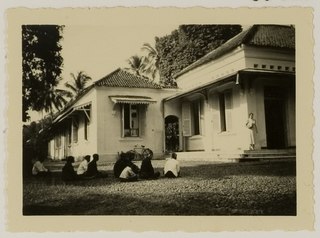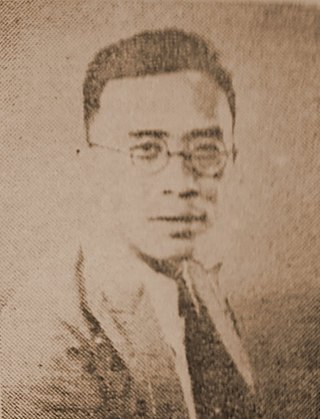
Sair Tjerita Siti Akbari is an 1884 Malay-language syair (poem) by Lie Kim Hok. Adapted indirectly from the Sjair Abdoel Moeloek, it tells of a woman who passes as a man to free her husband from the Sultan of Hindustan, who had captured him in an assault on their kingdom.

Lie Kim Hok was a peranakan Chinese teacher, writer, and social worker active in the Dutch East Indies and styled the "father of Chinese Malay literature". Born in Buitenzorg, West Java, Lie received his formal education in missionary schools and by the 1870s was fluent in Sundanese, vernacular Malay, and Dutch, though he was unable to understand Chinese. In the mid-1870s he married and began working as the editor of two periodicals published by his teacher and mentor D. J. van der Linden. Lie left the position in 1880. His wife died the following year. Lie published his first books, including the critically acclaimed syair (poem) Sair Tjerita Siti Akbari and grammar book Malajoe Batawi, in 1884. When van der Linden died the following year, Lie purchased the printing press and opened his own company.

Tjhit Liap Seng, also known as Bintang Toedjoeh in Malay, is an 1886 novel by Lie Kim Hok. It is considered the first Chinese Malay novel.

Tjoe Boe San was a Chinese nationalist, translator and newspaper editor in the Dutch East Indies, most notably editor and director of the influential Indonesian Chinese newspaper Sin Po until his death in 1925. Along with Kwee Kek Beng, he was a key member of the "Sin Po Group" which was a political faction of the Indonesian Chinese which believed that they should stay out of Dutch colonial politics and remain focused on China.
Keng Po was a Malay language Peranakan Chinese newspaper published in Batavia, Dutch East Indies from 1923 to 1958. During most of that time it was the second-most popular Malay-language Chinese newspaper in the Indies after Sin Po. It was also an important paper in the early period of Indonesian independence in the 1950s.
Yap Goan Ho was a Chinese Indonesian translator, businessman, bookseller, and publisher based in Batavia, Dutch East Indies. In the 1880s and 1890s, he was one of the first Chinese Indonesians to own a printing press and the first to publish Chinese language novels in Malay language translations.

Siem Piet Nio, who wrote under the pen name Hong Le Hoa, was an Indonesian language writer, magazine editor, journalist and Women's rights advocate from the Dutch East Indies who was active during the 1920s and 1930s.

Njonja Tjoa Hin Hoei, who was born Kwee Yat Nio and was also known by the Buddhist name Visakha Gunadharma, was a Chinese Indonesian journalist, writer, Buddhist figure, and political activist during the late colonial and early independence periods. She was especially known for being publisher and editor of a women's magazine Maandblad Istri which ran from the 1930s to the early 1950s.
Khoe Trima Nio, who published under the pen names Aster and L. S. G., was a Peranakan Indonesian language writer and journalist active in the Dutch East Indies during the 1930s. She was part of a small cohort of Chinese Indonesian women novelists and short story writers publishing during that time which included Nyonya The Tiang Ek, Tan Lam Nio and Yang Lioe.

Nona Tan Tjeng Nio was a Peranakan Malay language poet active in the 1890s. She was one of the earliest known Chinese Indonesian women writers to be published in the Indies; her poems are considered to have surprisingly modern themes and ideas for their time.

Phoa Tjoen Hoat, who also published under the name Th. H. Phoa Sr., was a Chinese Indonesian, Malay language journalist, translator and newspaper editor active in the Dutch East Indies in the early twentieth century.

Phoa Tjoen Hoay, who sometimes published as T. H. Phoa Jr., was a Chinese Indonesian, Malay language journalist, translator, and newspaper editor active in the Dutch East Indies in the early twentieth century. He translated a number of Chinese and European works into Malay, including seven volumes of Sherlock Holmes by Arthur Conan Doyle.

The Liep Nio was a Chinese Indonesian writer and playwright active in the 1930s in the Dutch East Indies. Little is known about her life aside from the fact that she was a Peranakan Chinese woman from Purbalingga in Central Java; she was probably born in the early twentieth century. She was part of the first generation of Indonesian women who to appear in print, which was almost unheard of before the 1930s; the first short writings by Native Indonesian and Indonesian Chinese women are thought to have appeared in newspapers in the 1910s and 1920s, but few were published in book form until the 1930s. The Liep Nio published poems, novels, plays, and short stories in literary magazines such as Tjerita Roman, Liberty, and Djawa Tengah Review.

Tan Hong Boen, commonly known by his pen name Im Yang Tjoe, was a Chinese Indonesian writer, journalist, and translator active in the Dutch East Indies and Indonesia from the 1920s to the 1950s. He also published occasionally under the pen names Madame D'Eden Lovely for romantic novels, Kihadjar Dharmopralojo for historical novels, and Kihadjar Soekowijono for Wayang stories. In 1933 he published a biography of Sukarno, whom he had shared a jail cell with in 1932; it seems to be the earliest known biography of Sukarno.

Lie Sim Djwe, who also published under the name Lie Sien Djioe, was a Chinese Indonesian writer, journalist and translator active in the Dutch East Indies and Indonesia from the 1910s until the 1950s. His major contribution was the translation of Chinese-language novels into Malay.

Lie Loan Lian Nio was one of the earliest known woman translators of Chinese language novels into Malay in the Dutch East Indies. She was active in the 1920s and mostly translated for the magazine Tjerita Baroe.

Penghidoepan was a monthly Peranakan Chinese, Malay-language literary magazine published in the Dutch East Indies from 1925 to 1942. It was one of the most successful literary publications in the Indies, publishing more than 200 novels and short stories during its run. Among its authors were many of the notables of the Chinese Indonesian literary world including Njoo Cheong Seng, Tan Hong Boen, and Tan Boen Soan.

Tjerita Roman was a monthly Peranakan Chinese, Malay-language literary magazine published in the Dutch East Indies from 1929 to 1942. It was one of the most successful literary publications in the Indies, publishing hundreds of novels, plays, and short stories during its run. Among its authors were many of the notables of the Chinese Indonesian literary world including Njoo Cheong Seng, Pouw Kioe An, Tan Boen Soan, and Liem Khing Hoo.
Lie On Moy (1884–1951) was a Peranakan Chinese journalist, writer and translator in the Dutch East Indies. She is thought to have been one of the first Peranakan women journalists and published writers in the Indies.

Pouw Kioe An was a Peranakan Chinese journalist, novelist, newspaper editor and translator from the Dutch East Indies who was active from the 1920s to the 1950s. He worked for most of the main Chinese Indonesian newspapers in Java during that time and published original novels and translations prolifically.

















